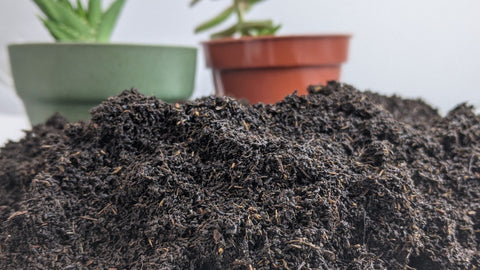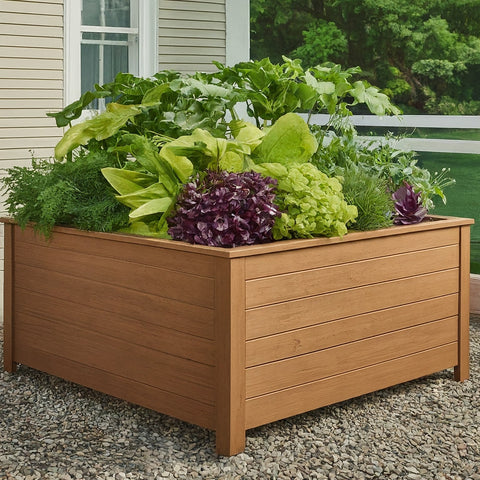
Can You Add Worms to Potted Plants?
The short answer is that yes, just as they add value to plants and soil in nature, earthworms can be beneficial in potted plants as well.
However, not every potted plant is a good candidate fort earthworms, so there are several considerations to factor in before buying worms and adding them to your plants or beds.
Can you add worms to potted plants?
Yes - Worms can thrive in certain potted plant set-ups and add value to the soil and roots as long as the environment is suitable for their survival. The key success factors when adding worms to potted plants include size of the pot or container, the type of potting soil, a food source for the worms, and the number of worms (aka density) to put in the potted plant based on its size. If adding worms is a problem, a great alternative for potted plants is to directly apply worm castings to the soil.

Here are more details on what to consider when adding worms to potted plants:
- Add worms to larger containers: Earthworms are more suitable for larger containers where there is enough space and soil for them to thrive without becoming stressed or overcrowded. For density, 10-25 worms per square foot is plenty for most larger potted plant containers (e.g., planters).
- Choose the right soil type: Store-bought potting soils often have chemicals that can harm worms, so it’s important to use natural or organic potting soils with neutral pH and no harsh chemicals or ingredients.
- Pick the right worm species based on their size: Smaller worms like red wigglers generally work better than nightcrawlers due to their size and space constraints.
- Feed & Water: Worms need moist soil and a food source, so regular watering and small amounts of compost or decaying organic matter like leaf litter or fruit will help keep them alive. When watering, go for soil that is moist like wrung out sponge (1-2 drops should emerge when a handful is squeezed)
- Temperature: Most worms thrive in temperatures between 40 degrees and 90 degrees F. If the potted plants sit in the hot sun, temperatures may get too hot for the worms to survive.
- Test & Start Small: When adding worms to potted plants, planters, or containers, start small with 100-250 worms and see how they do over 3-4 weeks. If the worms seem happy and stay alive, then you can be comfortable adding more worms over time.
If your set-up to address the above success factors isn’t good, then consider buying worm castings as an alternative. Castings are high in minerals and biology that helps unlock nutrients that are easy for plants to consume.

Although worm castings are more expensive than fertilizers, they are much better for the environment. And because castings are so dense in beneficials, you only need to apply a small amount per plant to get huge benefits.
Benefits of Adding Worms to Potted Plants
Adding earthworms to potted plants can lead to healthier, more aerated soil that supports plant growth. In addition, worms will leave behind worm castings, which are a superfood for plant growth and an all-natural amendment that enriches the soil.
Frequently Asked Questions: Can You Add Worms to Potted Plants
Is it good to put worms in your potted plants?
Worms can help aerate soil and produce castings that will help potted plants in the same way worms aid plant health in nature.
However, success with putting worms in potted plants depends on the size of the container (larger is better), a food source for the worms, and using organic potting soils that won’t harm the worms.

Larger beds and planters are a better option for worms than small pots.
A good alternative for worms is simply applying worm castings directly to the soil of the potted plants.
How do you add worms to a container garden?
Adding worms to a container garden is simple and straightforward. Simply place the worms on the surface of the garden soil. Worms do not like light so they will burrow into the soil quickly. Once the worms have been added, it’s important to keep the soil moist and ensure the worms have a steady source of food.
Can you put worms directly into soil?
Yes - you can put worms directly into soil. Worms are commonly added to gardens, lawns, gardens, and even larger potted plants. Worms need moist conditions, shade, and a food source for survival, so it’s important to ensure these factors are met before adding worms.
Adding a small amount of worms as a test is usually a good first step when considering adding worms to your garden or raised beds.
Observe the worms for a few weeks and if they are active and appear healthy it is generally safe to add more.
Can worms be harmful to plants?
No, common earthworms in the United States like Red Wigglers and Nightcrawlers are not harmful to plants, gardens, yards, or soils.

Worms are never harmful to plants and only eat decaying matter.
In fact, the presence of earthworms generally means soil conditions are good. Earthworms will only eat dead or decaying organic matter so they pose no risk to plants, leaves, stems, or root systems that are living.
How do worms affect a potted plant?
Worms can offer the same benefits to potted plants as they offer to plants in nature. These benefits include aerating the soil and producing worm castings rich in biology that unlock minerals and nutrients for plant root systems. However, adding worms to smaller potted plants may not offer many benefits as worms tend to do better in larger container (e.g., raised beds, gardens, etc).
For smaller potted plants, worm castings are a great alternative that will give many of the same benefits to the plants and soil.
Are worms good for indoor plants?
Worms can provide the same benefits to indoor plants that they provide to lawns, gardens, and other soils. However, worms need space to breed and thrive over time, and most indoor plants will be too small to support a happy and growing worm population.
A good alternative to adding worms to indoor plants is to add worm castings - castings are rich in beneficial biology that helps unlock nutrients and minerals for plants and their root systems.
Do earthworms live in potting soil?
Earthworms are primitive creatures and can not live in potting soils that consist of harsh chemicals or man-made substances. Earthworms prefer natural soils, including topsoil, coco coir, finished compost, peat moss, and even moist shredded cardboard. If you are unsure about worms surviving in your potting soils, buy a small number of worms (50-100) and test to see how the worms do over 3-4 weeks.
Can you add worms to potted plants indoors?
Worms can be added to potted plants indoors, but worms need space to breed and grow over time. Since most potted plants indoors are smaller, the plants will not be a great fit for worms to survive and thrive. A better alternative that will offer many of the same benefits is to apply small amounts of worm castings around the base of the plants. Castings will improve soil health and provide beneficial biology that help plants thrive.
Can you add worms to potted plants in winter?
Earthworms are comfortable in the same temperatures that humans prefer, namely 40-90 degrees Fahrenheit. If temperatures in your area are commonly below 40 degrees in the winter, then adding worms to potted plants can be an issue. If your potted plants or beds are on the larger size (at least 3’ W and 3’ L with a vertical depth of 30 inches or more), worms can survive by digging into the soil when surface conditions are too cold.

Worms need surface area and vertical depth to survive in cold and hot weather.
We recommend either using worm castings instead of worms or buying a small number of worms and testing in 1 container to see how they do.
Can you add earthworms to potted plants?
Yes, adding earthworms to potted plants can be beneficial, but adding worm castings is generally a better option for potted plants. Most potted plants are too small to support a worm population as space constraints and available food will be issues for the worms. Worm castings, however, offer the biological and nutrient cycling benefits of worms without the drawbacks of keeping worms alive in a small container.

